Illinois
Type |
Symbol |
Year Est. |
|---|---|---|
State Mineral |
Fluorite |
1965 |
State Fossil |
Tully Monster |
1989 |
State Mineral: Fluorite
5 ILCS 460/25
from Ch. 1, par. 2901-25
Sec. 25. State mineral. The mineral calcium fluoride, commonly called "fluorite", is designated the official State mineral of the State of Illinois.
Source: P.A. 90-655, eff. 7-30-98.
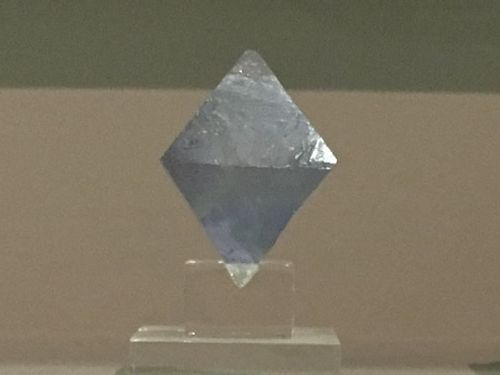
Fluorite crystal from Chicago. Crystal is displayed at Chicago's Field Museum
Fluorite (sometimes called Fluorspar) is a mineral that is part of the halide family and is composed of calcium and fluorine (CaF2). Named after the Latin word fluere, meaning "to flow", fluorite was frequently used as a flux, due to its ability to easily melt. Fluorite has a couple of diagnostic properties that make it very easy to identify. It is translucent or transparent, and is the only common mineral to have four directions of cleavage. The cleavage, which is the ability to break along specific planes of weakness, causes it to produce an octahedron shaped crystal (i.e. two pyramids attached to each other at the base, as seen in the image). In addition to a low melting point, it is also a fairly soft mineral, being used to denote the hardness of 4 on Mohs Hardness Scale. Fluorite can be found in a wide variety of colors including purple, green, yellow, blue, pink, and brown, however fluorite has a special property in that it fluoresces under a black (UV) light. This means that it glows, a process that, when discovered, was named after the mineral fluorite. Fluorite is formed when hydrothermal fluids flow through limestones, dolostones, and other rocks depositing not only fluorite minerals but also frequently metallic ores including tin, silver, lead, zinc, and copper. Fluorite has a lot uses, making it a valuable ore, the primary use of which is as a source for the element fluorine. From its namesake, Fluorite has been used as a flux for steel production, helping to remove impurities from the melt. In chemical applications, it is used to manufacture hydrofluoric acid (HF), which then can be used to create fluorocarbon chemicals, foam blowing agents, refrigerants, and a variety of fluoride chemicals. It is also used to manufacture specialty glass, ceramics, enamelware, the Teflon coating, optical lenses, or even just as a gemstone. Most of the fluorite in the US has been mined out with the last mines closing in 1995 due to low production and cheaper sources elsewhere. Otherwise, most of the fluorite used in the US is imported from China, Mexico, Mongolia, and South Africa.
Geologic map of the Illinois-Kentucky Fluorspar Mining District. Image courtesy of the USGS.
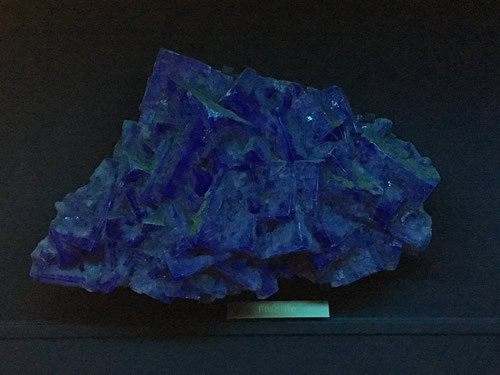
Fluorescing of Fluorite crystals at Chicago's Field Museum
The area where the fluorite is found within Illinois is mainly in Hardin and Pope Counties, however the region also extends into Kentucky, encompassing an area known as the Illinois-Kentucky Fluorspar Mining District. Initially, this area was mined for the related lead deposits starting around 1835. Fluorite was initially thought to be worthless and therefore was disposed of in order to get to the more valuable and related minerals. However, once the value of fluorite had been recognized in the later 1800's as a flux, more attention was paid to mining it. From 1880 to 1976, this region had produced ~9.5 million tons of ore, 80% of the total US production. The region where the fluorite is being mined was a depositional basin back in the Paleozoic, specifically the Mississippian (~330 million years ago), when the host rocks were laid down. The host rocks, specifically the upper part of the Meramecian and the lower part of the Chesterian Series are predominantly limestones, with some sandstones and shales interbedded. The noted Bethel Sandstone on the legend of the map above represents the near base of the Chesterian Series of rock units. The Meramecian limestone beds, made up predominantly of the shells of marine organisms, were laid down in a near-shore/continental shelf marine environment. The deposition of the Bethel Sandstone beds marks a transition from mostly marine limestone to more near shore clastics like sandstone and shale deposits. Later this region was inundated with northeast to southwest running faults, as can be seen on the map above. These faults allowed for the transmission of Jurassic Age (~175 million years ago) hydrothermal fluids, which were related to nearby volcanic activity. These hydrothermal fluids, rich in the element fluorine, mixed with the calcium rich limestones to produce abundant deposits of fluorite, along with many other valuable ore minerals. Although the majority of fluorite in the US has come from these deposits, eventually cheaper sources of fluorite from outside the country as well as dwindling reserves forced many of the mines to shut down in the late 1980's. In December of 1995, the last of the Illinois fluorite mines closed. The over abundance of Illinois fluorite specimens kept the price of Illinois fluorite fairly steady until around 2009, when the price started to steeply increase. Today it costs ~10 times as much for an Illinois specimen of fluorite than it cost back in the early 1990's.
State Fossil: Tully Monster
5 ILCS 460/60
from Ch. 1, par. 2901-60
Sec. 60. State fossil. The fossil Tullimonstrum gregarium is designated the official State fossil of the State of Illinois.
Source: H.B. 86-346
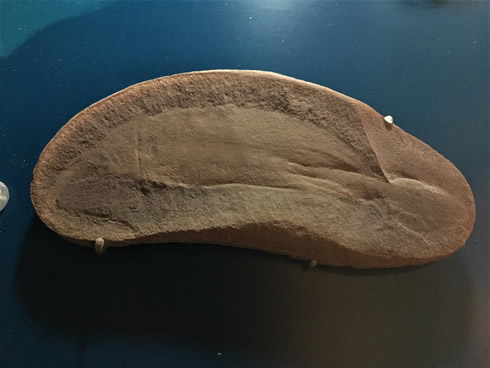
Tully Monster fossil from Illinois. Fossil is displayed at Chicago's Field Museum
The Tully Monster, formally named Tullimonstrum gregarium, is a rather bizarre fossil found in the Mazon Creek fossil beds of Illinois. The Mazon Creek is part of the Middle Pennsylvanian age (~309 million year old) Francis Creek Shale Formation. Located outside of Chicago, near Morris in Grundy County, the beds are shale interspersed with coal seams as well as siderite nodules. Siderite, also known as iron carbonate, forms from the interaction of seawater, mud, and organic matter of dead animals to cause layers of ironstone build up and harden around the dead organism. The nodules then survive through the ages as much of the shale is weathered away. Once broken open, the nodules will often reveal soft bodied organisms in tremendous detail, which are frequently not able to preserved in other forms of fossilification. The Tully Monster is one of these such organisms.
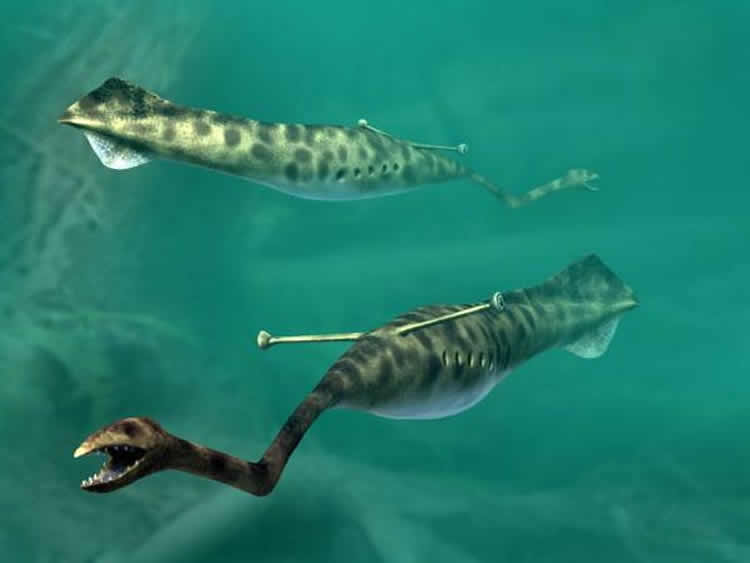
Possible reconstruction of the Tully Monster, Tullimonstrum gregarium. Image courtesy of Wikimedia CC BY-SA
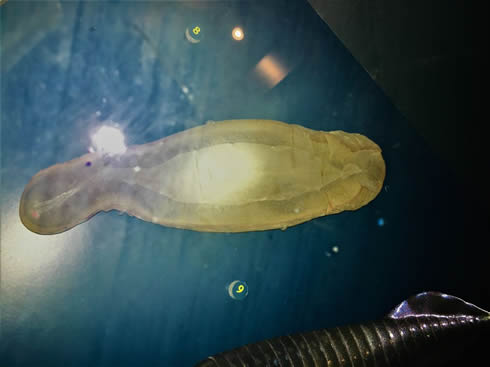
Tully Monster fossil from Illinois. Fossil is displayed at Chicago's Field Museum
The proximity of the coal seams to the iron nodules brought fossils collectors into the area when strip mining for coal began in the 1850's. The Tully Monster itself wasn't discovered until the late 1950's by Francis Tully, an amateur fossil collector. In 1966, it was named in honor of its discoverer with the name it was generally known as, the scientific version of "Tully Monster". And this fossil truly was a "monster". Not fitting into any of the known classifications at the time, the Tully Monster is unique to Illinois, being found nowhere else in the world. Over the past 70 years, several papers have come out describing what this organism actually is, with a 2016 paper describing the organism as a type of lamprey, a jawless fish. Some of the previous thoughts were that it could be a segmented worm or perhaps a swimming slug. As can be (kind of) seen in the fossil above, the animal was comprised of a torpedo shaped body, a jointed trunk-like snout that ended in a claw-like structure with teeth, and had eyes on the ends of a rigid bar extending sideways from the head. The identification of the possible presence of a notochord, placed the animal within the vertebrates. However, the ever winding story of the Tully Monster isn't settled yet. A 2019 study called into question previous studies, specifically what the eyes were made out of, placing it possible outside of the group of vertebrates. So, whatever the Tully Monster is, it is still a mystery and it is still weird.
References
https://statesymbolsusa.org/states/united-states/illinois
https://geology.com/minerals/fluorite.shtml
https://www.mindat.org/min-1576.html
https://pubs.usgs.gov/pp/0970/report.pdf
https://isgs.illinois.edu/outreach/geology-resources/fluorite-illinois-state-mineral
https://www.treasuremountainmining.com/index.php?route=pavblog/blog&id=94
https://onlinelibrary.wiley.com/doi/abs/10.1111/j.1502-3931.1987.tb02028.x
https://ucmp.berkeley.edu/carboniferous/mazon.html
https://www.scientificamerican.com/article/tully-monster-mystery-solved-scientists-say/
https://www.ilga.gov/legislation/ilcs/ilcs3.asp?ActID=132&ChapterID=2
Geology of Illinois's National Parks
Through Pictures
(at least the one's I have been to)
None yet!


